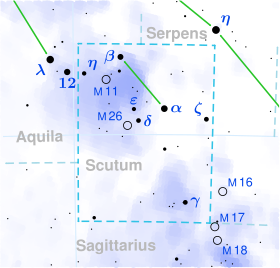Star in the constellation Scutum
Eta Scuti , Latinized from η Scuti, is a single[ 10] star in the southern constellation of Scutum , near the constellation border with Aquila . Eta Scuti was a latter designation of 9 Aquilae before the official constellation borders were set in 1922.[ 11] apparent visual magnitude of +4.83.[ 2] light-years from the Sun based on parallax , and is moving closer with a radial velocity of −92 km/s.[ 1]
This is an aging giant star with a stellar classification of K1-III.[ 4] core , the star cooled and expanded until currently it has 12[ 1] red clump giant, which indicates it is presently on the horizontal branch and is generating energy through core helium fusion .[ 3] [ 8] mass of the Sun .[ 6] [ 1] Sun's luminosity from its swollen photosphere at an effective temperature of K [ 1]
References
^ a b c d e f g h i j k l m Brown, A. G. A. ; et al. (Gaia collaboration) (August 2018). "Gaia Data Release 2: Summary of the contents and survey properties" . Astronomy & Astrophysics 616 . A1. arXiv :1804.09365 Bibcode :2018A&A...616A...1G doi :10.1051/0004-6361/201833051 Gaia DR2 record for this source at VizieR .^ a b c Anderson, E.; Francis, Ch. (2012). "XHIP: An extended hipparcos compilation". Astronomy Letters . 38 (5): 331. arXiv :1108.4971 Bibcode :2012AstL...38..331A . doi :10.1134/S1063773712050015 . S2CID 119257644 . Vizier catalog entry ^ a b Alves, David R. (August 2000), "K-Band Calibration of the Red Clump Luminosity", The Astrophysical Journal , 539 (2): 732– 741, arXiv :astro-ph/0003329 Bibcode :2000ApJ...539..732A , doi :10.1086/309278 , S2CID 16673121 . ^ a b Keenan, Philip C.; McNeil, Raymond C. (1989). "The Perkins catalog of revised MK types for the cooler stars". The Astrophysical Journal Supplement Series . 71 : 245. Bibcode :1989ApJS...71..245K . doi :10.1086/191373 . ^ a b Mallama, A. (2014). "Sloan Magnitudes for the Brightest Stars". The Journal of the American Association of Variable Star Observers . 42 (2): 443. Bibcode :2014JAVSO..42..443M . Vizier catalog entry ^ a b c d Reffert, Sabine; Bergmann, Christoph; Quirrenbach, Andreas; Trifonov, Trifon; Künstler, Andreas (2015). "Precise radial velocities of giant stars". Astronomy & Astrophysics . 574 : A116. arXiv :1412.4634 Bibcode :2015A&A...574A.116R . doi :10.1051/0004-6361/201322360 . hdl :10722/215277 . S2CID 59334290 . Vizier catalog entry ^ De Medeiros, J. R.; Alves, S.; Udry, S.; Andersen, J.; Nordström, B.; Mayor, M. (2014). "A catalog of rotational and radial velocities for evolved stars". Astronomy & Astrophysics . 561 : A126. arXiv :1312.3474 Bibcode :2014A&A...561A.126D . doi :10.1051/0004-6361/201220762 . S2CID 54046583 . Vizier catalog entry ^ a b da Silva, L.; et al. (November 2006), "Basic physical parameters of a selected sample of evolved stars", Astronomy and Astrophysics , 458 (2): 609– 623, arXiv :astro-ph/0608160 Bibcode :2006A&A...458..609D , doi :10.1051/0004-6361:20065105 , S2CID 9341088 ^ "eta Sct" . SIMBAD Centre de données astronomiques de Strasbourg . Retrieved 2019-08-23 .^ Eggleton, P. P.; Tokovinin, A. A. (September 2008), "A catalogue of multiplicity among bright stellar systems", Monthly Notices of the Royal Astronomical Society , 389 (2): 869– 879, arXiv :0806.2878 Bibcode :2008MNRAS.389..869E , doi :10.1111/j.1365-2966.2008.13596.x S2CID 14878976 . ^ Wagman, M. (August 1987). "Flamsteed's Missing Stars". Journal for the History of Astronomy . 18 (3): 213. Bibcode :1987JHA....18..209W . doi :10.1177/002182868701800305 . S2CID 118445625 .
